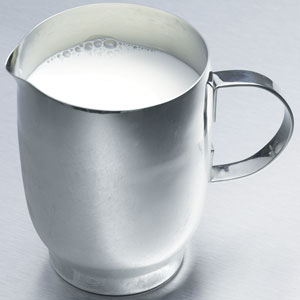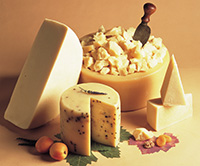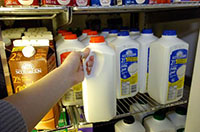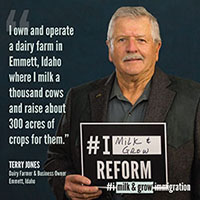 The nation’s dairy farmers and dairy companies today expressed their opposition to new legislation in Congress that would allow the interstate sales of raw milk, saying that any additional availability of the product will increase the number of sicknesses and deaths of people who consume it.
The nation’s dairy farmers and dairy companies today expressed their opposition to new legislation in Congress that would allow the interstate sales of raw milk, saying that any additional availability of the product will increase the number of sicknesses and deaths of people who consume it.
The International Dairy Foods Association and the National Milk Producers Federation said that “the risks inherent in raw dairy products are not worth any imagined benefits to either consumers or producers of unpasteurized milk products. Raw milk skips the pasteurization safety process, and this is playing Russian roulette with the health of too many Americans – including many of our children.”
The two associations urged lawmakers to reject the “Interstate Milk Freedom Act of 2014,” a bill introduced by Rep. Thomas Massie (R-KY), which would repeal a long-standing ban on the sales across state lines of unpasteurized milk. Federal law currently gives states the discretion to regulate raw milk within their borders, but the dairy organizations expressed concern that repealing the interstate ban would greatly increase the production and consumption of a known health hazard.
“If this measure passes, those most vulnerable to dangerous pathogens – children – are the ones who will suffer the most. The benefits of consuming raw milk are illusory, but the painful costs of illness and death are very real,” said Jim Mulhern, President and CEO of the National Milk Productions Federation.
“Consumption of raw milk is a demonstrated public health risk. The link between raw milk and foodborne illness has been well‐documented in the scientific literature, with evidence spanning nearly 100 years. Raw milk is a key vehicle in the transmission of human pathogens, including E. coli O157:H7, Campylobacter, Listeria monocytogenes, and Salmonella,” he stated.
Several states in recent years have considered and approved legislation expanding the sales of raw milk, even as the product has been repeatedly linked to serious illnesses from coast to coast.
“Our dairy industry benefits from a very high degree of consumer confidence – confidence built in large part due to the excellent food safety record of milk and dairy products,” said Connie Tipton, President and CEO of the International Dairy Foods Association. “While choice is an important value, it should not pre‐empt consumers’ well‐being. To further ease the regulations surrounding the national sale of raw milk is an unnecessary risk to consumer safety.”
The two dairy groups said that the Centers for Disease Control has reported that nearly 75 percent of raw milk‐associated outbreaks have occurred in states where sale of raw milk was legal. Only one to two percent of reported foodborne outbreaks are attributed to dairy products. However, of those, over 70 percent have been attributed to raw milk and inappropriately‐aged raw milk cheeses.
“Seldom has the science behind public health policy been so clearly one-sided. Pathogenic bacteria can be found on any dairy farm, regardless of its cleanliness or the good intentions of its owner. This legislation is a threat to public health and should not be approved,” the organizations said.
The International Dairy Foods Association (IDFA), Washington, D.C., represents the nation’s dairy manufacturing and marketing industries and their suppliers, with a membership of 550 companies within a $125-billion a year industry. IDFA is composed of three constituent organizations: the Milk Industry Foundation (MIF), the National Cheese Institute (NCI) and the International Ice Cream Association (IICA). IDFA’s nearly 200 dairy processing members run nearly 600 plant operations, and range from large multi-national organizations to single-plant companies. Together they represent more than 85 percent of the milk, cultured products, cheese, ice cream and frozen desserts produced and marketed in the United States. IDFA can be found online at www.idfa.org.
The National Milk Producers Federation (NMPF), based in Arlington, VA, develops and carries out policies that advance the well being of dairy producers and the cooperatives they own. The members of NMPF’s cooperatives produce the majority of the U.S. milk supply, making NMPF the voice of more than 32,000 dairy producers on Capitol Hill and with government agencies.

 A bipartisan majority of the U.S. Senate weighed in this week on the importance of rejecting European Union efforts to restrict the use of common food names, including a variety of popular, well-known cheeses, used by U.S. dairy producers and companies.
A bipartisan majority of the U.S. Senate weighed in this week on the importance of rejecting European Union efforts to restrict the use of common food names, including a variety of popular, well-known cheeses, used by U.S. dairy producers and companies. With the new farm bill having been signed into law (left), attention has shifted to how the Agriculture Department will implement the groundbreaking margin insurance program for dairy farmers.
With the new farm bill having been signed into law (left), attention has shifted to how the Agriculture Department will implement the groundbreaking margin insurance program for dairy farmers. A rash of news stories in February has focused on the potential impact of rising farm-level milk prices, stoking fears of record-high consumer prices for dairy foods.
A rash of news stories in February has focused on the potential impact of rising farm-level milk prices, stoking fears of record-high consumer prices for dairy foods. NMPF continues to push immigration reform efforts on Capitol Hill. Recently, the organization co-hosted a briefing for congressional offices with other agricultural organizations, and the Partnership for a New American Economy, to highlight agriculture’s struggle with the nation’s current immigration system. Among the speakers was a dairy farmer who spoke about the challenges he faces with securing workers and the inadequacies of the H-2A visa program for the dairy industry.
NMPF continues to push immigration reform efforts on Capitol Hill. Recently, the organization co-hosted a briefing for congressional offices with other agricultural organizations, and the Partnership for a New American Economy, to highlight agriculture’s struggle with the nation’s current immigration system. Among the speakers was a dairy farmer who spoke about the challenges he faces with securing workers and the inadequacies of the H-2A visa program for the dairy industry.



